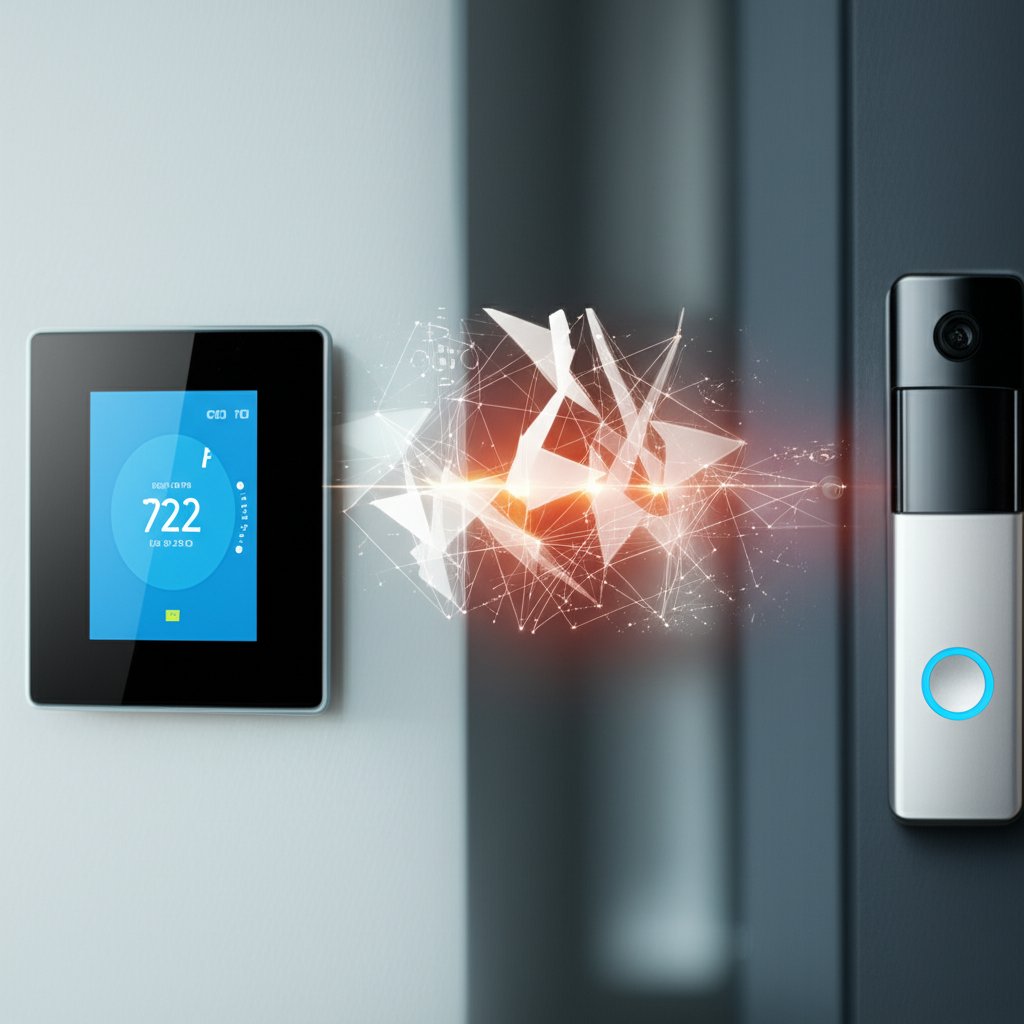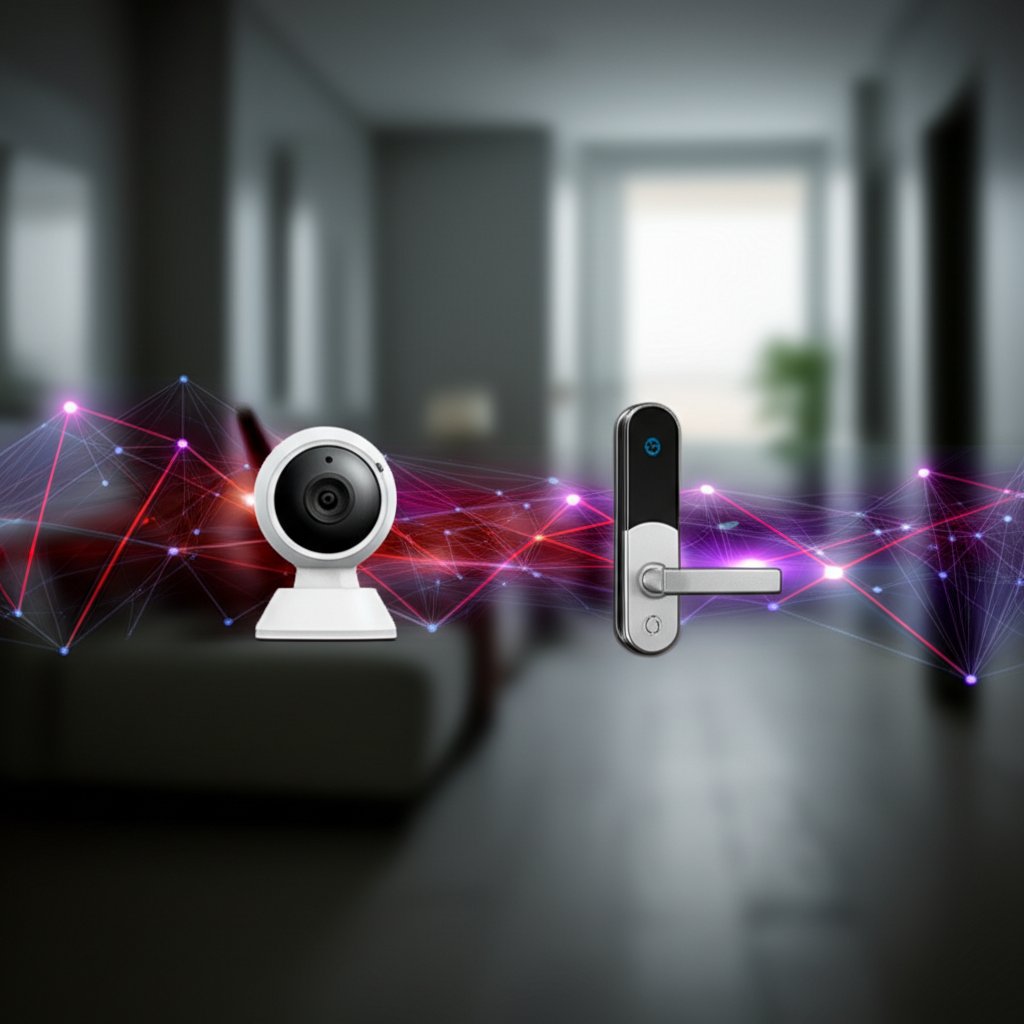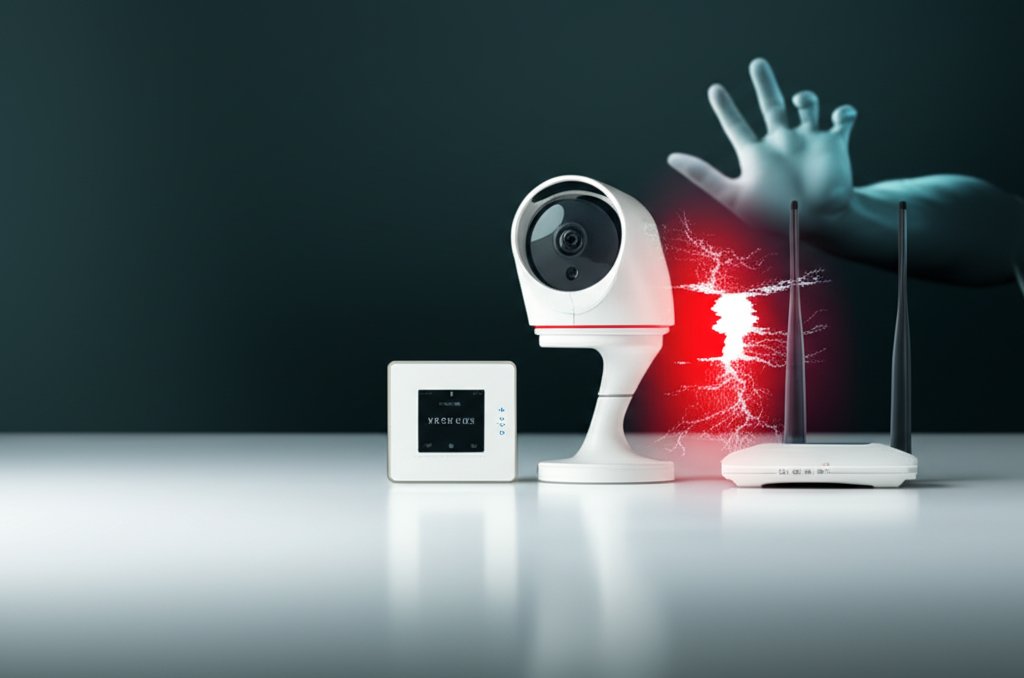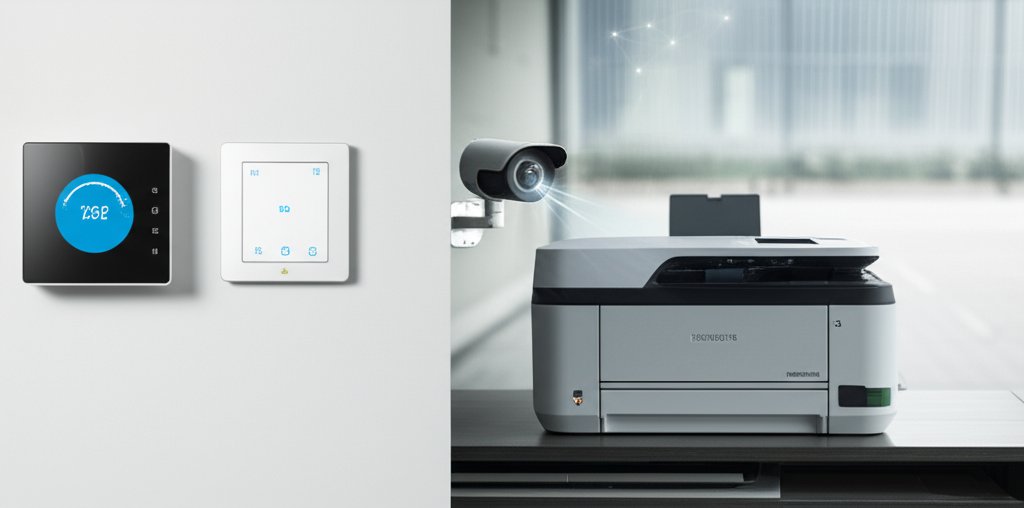The allure of a smart home is undeniable. We effortlessly dim lights with a voice command, monitor our property from afar, and enjoy thermostats that intuitively learn our preferences. This convergence of convenience and technology is truly a marvel. Yet, beneath this seamless façade lies a sophisticated network of devices, all interconnected via your internet and, by extension, to the wider world. This pervasive connectivity, while incredibly beneficial, inherently introduces a layer of security risks—risks many users may not even be aware of.
You’ve likely found yourself pondering: “How can I ensure my smart doorbell isn’t an unwitting entry point for attackers?” or “Is my smart thermostat inadvertently sharing sensitive data?” These are not just valid questions; they are critical concerns that resonate with countless smart home owners. The deluge of technical jargon can be daunting, leading many to simply hope for the best. This is precisely where we step in. This guide transcends a mere list of tips; it’s your definitive, actionable resource designed to demystify smart home security. We’ll cut through the complexity, providing clear, non-technical steps to secure everything from your foundational network settings to individual device configurations, protecting your digital sanctuary and personal privacy from the ground up. Understanding the nuances of such advanced security models, including potential Zero-Trust failures, is key to comprehensive protection.
Our mission is to empower you to take full control of your smart home security. Consider this your comprehensive playbook for enduring peace of mind. Let’s embark on securing your connected world.
Understanding Smart Home Vulnerabilities: What Makes Your Devices a Target?
Before we can effectively defend our smart home, we must first understand the threats we’re defending against. This isn’t about fostering alarm; it’s about being thoroughly informed. Despite their sophisticated benefits, smart devices can sometimes possess surprising vulnerabilities when it comes to security. Let’s examine the common reasons why your gadgets might become targets.
Weak Default Passwords & Easy Access Points
Often, it’s the most basic oversights that create the greatest risks. Many smart devices, straight out of the box, come equipped with generic default passwords such as “admin,” “12345,” or even no password at all. Imagine buying a house where the front door is unlocked and the key is left under the mat—it’s an open invitation for trouble. These easily guessed or publicly known credentials are a cybercriminal’s preferred entry point. They don’t need to be master hackers; they simply need to try the obvious.
Outdated Software & Firmware
Just like your smartphone or computer, smart home devices operate on software, commonly referred to as firmware. Regrettably, not all manufacturers consistently release updates to address newly discovered vulnerabilities. An outdated device is akin to leaving a window open after learning there’s a burglar in the neighborhood. These unpatched flaws represent prime targets for cyber attackers, enabling them to gain unauthorized access or even seize control of your devices.
Unsecured Wi-Fi Networks
Your Wi-Fi router serves as the undisputed front door to your entire smart home ecosystem. Every smart device, from your video doorbell to your smart light bulbs, connects through it. If this front door isn’t properly locked and fortified, the individual security of your devices becomes largely irrelevant; an attacker could potentially bypass them all and access your entire home network. We cannot overstate the critical importance of router security.
Data Privacy Concerns
A crucial question we must ask ourselves is: what data are my devices collecting, and where is it being sent? Smart devices frequently gather a wealth of information about your habits, daily routines, and even your conversations. This can encompass video feeds, audio recordings, location data, and energy usage patterns. If this data isn’t adequately encrypted or secured by the manufacturer, or if you’re not diligent with privacy settings, it risks being exposed, shared, or even sold. This is your personal data, and you absolutely should maintain control over it.
The “Weakest Link” Principle
Consider a chain; its strength is ultimately determined by its weakest link. Your smart home network operates on this very principle. A single vulnerable device—perhaps an older smart plug that no longer receives security updates—could become the weak link that compromises your entire network. Once one device is breached, an attacker might leverage it as a stepping stone to access other, more sensitive devices or even your personal computers and data. This reality necessitates a holistic approach to secure every component of your connected home.
Fortifying Your Foundation: Smart Home Router Security
As we’ve established, your Wi-Fi router is the cornerstone of your smart home’s defenses. It acts as the primary gatekeeper, and securing it properly represents the single most impactful step you can take. Let’s ensure that gate is impenetrable, offering a strong foundation for securing your home network.
Change Default Router Credentials IMMEDIATELY
This is rule number one, and it is astonishingly overlooked. Your router came with a default username and password, often printed on the device itself or easily discoverable online. Hackers are well aware of these defaults. Access your router’s settings (typically by entering its IP address, such as 192.168.1.1, into a web browser) and change both the administrator username and password to something robust and unique. Additionally, rename your Wi-Fi network (SSID) to something less identifiable than the factory default (e.g., “MyHomeNetwork” instead of “Linksys12345”).
Strong Wi-Fi Encryption (WPA2/WPA3)
Your Wi-Fi encryption protocol scrambles the data that travels between your devices and your router, rendering it unreadable to anyone attempting to intercept it. Ensure your router is configured to use WPA2-AES or, even better, WPA3 encryption. While WPA2 is currently the standard, WPA3 offers enhanced security, particularly against brute-force attacks. Avoid older, weaker protocols like WEP or WPA (TKIP), as they are easily compromised. You can typically find and configure this setting within your router’s wireless security section.
Create a Dedicated Guest Network (and an IoT Network)
Segmenting your network is a sophisticated yet accessible practice for everyday users. Most modern routers provide the option to create a separate “guest network.” Utilize this for visitors. Furthermore, if your router supports it, create a distinct network specifically for your IoT (Internet of Things) devices. This isolates your smart gadgets from your main network, where your computers, smartphones, and sensitive data reside. Should an IoT device be compromised, it cannot easily pivot to your primary network. This is a powerful strategy for enhancing your smart home network protection.
Disable Unnecessary Features
Fewer open doors equate to fewer opportunities for unauthorized entry. Features like WPS (Wi-Fi Protected Setup) and UPnP (Universal Plug and Play) are designed for convenience but can introduce significant security vulnerabilities. WPS, for instance, has known flaws that simplify the process for attackers to guess your Wi-Fi password. UPnP can allow devices to open ports on your firewall without your explicit permission. We strongly recommend disabling both of these features in your router settings unless you have a very specific, thoroughly understood need for them.
Enable Your Router’s Firewall
Your router almost certainly incorporates a built-in firewall, and it represents a crucial, foundational layer of defense. Ensure it is enabled. A firewall acts as a filter, controlling which traffic can enter and exit your network. It helps block unauthorized access attempts and prevents malicious software from communicating with external servers. While not an absolute shield, it is a fundamental component of robust home network security.
Keep Your Router’s Firmware Updated
Recall our discussion about outdated software being a risk? Your router’s firmware is no exception. Manufacturers regularly release updates to fix bugs, enhance performance, and patch newly discovered security vulnerabilities. Check your router’s administration panel for a firmware update section or consult your router’s manual. Some routers are capable of automatic updates, which is the ideal scenario. Make it a habit to check for updates every few months; it requires minimal effort for substantial smart home network protection.
Consider Upgrading Your Router
If your router is several years old, it may not support the latest security protocols like WPA3 or might no longer receive firmware updates from its manufacturer. An outdated router is a potential weak link. Investing in a newer, more secure router can significantly bolster your overall smart home security posture. Look for routers that prioritize security features, offer robust update support, and ideally, support network segmentation specifically for IoT devices.
Securing Your Smart Devices: From Light Bulbs to Locks
Beyond your router, each individual smart device demands its own careful attention. Every gadget you integrate into your home represents a potential entry point, and we must diligently secure each one.
Change All Default Device Passwords
This point bears repeating because of its paramount importance: every single smart gadget you own, from your smart doorbell to your robot vacuum, requires a unique, strong password. Never use the factory default. Never reuse the same password across multiple devices. Treat each device as its own mini-computer that demands individual protection. This is fundamental to effective IoT device security.
Implement Strong, Unique Passwords for Every Device/Account
You know the drill: long, complex passwords utilizing a mix of uppercase and lowercase letters, numbers, and symbols. But how can you possibly remember them all? This is where a reputable password manager becomes an indispensable tool. It generates and securely stores unique, strong passwords for all your online accounts and smart devices. You only need to remember one master password, and the manager handles the rest, drastically reducing your risk. For an even more seamless and secure experience, you might also explore the potential of passwordless authentication.
Enable Multi-Factor Authentication (MFA) Everywhere Possible
Think of MFA as an essential second lock on your digital door. Even if an attacker somehow obtains your password, they would still require a second piece of information—typically a code sent to your phone or generated by an app—to gain access. Most major smart home platforms (such as Google Home, Alexa, Apple HomeKit) and many individual device manufacturers offer MFA. Enable it. Seriously, enable it on every account that supports it. It stands as one of the most effective cybersecurity measures you can possibly take.
Regularly Update Device Firmware and Software
Just like your router, your smart devices need to remain updated. Firmware updates frequently include critical security patches for vulnerabilities that have been discovered. Enable automatic updates whenever available. If not, establish a quarterly routine to manually check for updates across all your smart devices. This is a critical habit for ongoing smart home network protection.
Review Privacy Settings and Permissions
Dedicate a few minutes to explore the privacy settings within each smart device’s accompanying app. You might be surprised by the data they are collecting or the permissions they are requesting. Limit data collection to only what is absolutely essential for the device to function. For instance, does your smart light bulb truly require access to your microphone or location? Probably not. Be an active participant in managing your online privacy.
Disable Unused Features (e.g., Remote Access, Bluetooth)
Any feature you are not actively using can represent an unnecessary entry point for an attacker. If you don’t need remote access to a particular device, disable it. If your smart speaker has Bluetooth but you never utilize it, turn it off. Reducing the “attack surface”—the number of potential vulnerabilities—is a core principle of digital security. This simple step significantly enhances your IoT device security.
Research Before You Buy
Prevention is invariably superior to cure. Before introducing any new smart device into your home, conduct a quick search for its security track record. Look for brands with transparent privacy policies, a clear commitment to regular firmware updates, and robust encryption standards. Check independent reviews for any reported security issues. A little upfront research can spare you significant headaches down the line.
Disconnect Unused Devices
If you possess old smart devices gathering dust in a drawer, or if you’ve determined a device no longer adds value, disconnect it from your network. Better yet, unplug it entirely. An unused device that remains connected is a potential, unmonitored vulnerability. If you don’t require its “smart” functionality, revert it to a “dumb” device, or simply remove it from your digital landscape altogether.
Everyday Habits for a Cyber-Secure Smart Home
Beyond technical configurations, your daily habits play an immense role in maintaining a secure smart home. Consider these your personal digital security best practices.
Be Wary of Public Wi-Fi: Use a VPN If You Must
Public Wi-Fi networks (such as those found at coffee shops or airports) are notoriously insecure. Avoid accessing or controlling your smart home devices or apps while connected to public Wi-Fi. If you absolutely must, utilize a Virtual Private Network (VPN). A VPN encrypts your internet traffic, creating a secure tunnel and shielding your data from prying eyes, even on unsecured networks. It’s a crucial tool for protecting connected devices when you’re on the go.
Monitor Your Network for Unknown Devices
Periodically check your router’s administration panel for a comprehensive list of all connected devices. Do you recognize every entry? If you spot an unfamiliar device, it could be a clear sign of unauthorized access. You can typically eject unknown devices from your network and then immediately change your Wi-Fi password. Staying vigilant is paramount for proactive smart home network protection.
Understand the Apps You Use
Each smart device is accompanied by its own application, and these apps frequently request permissions on your smartphone or tablet. Pay close attention to the permissions you are granting. Does a smart light bulb app truly require access to your contacts or microphone? Likely not. Regularly review app permissions on your mobile devices and revoke any that appear excessive or unnecessary. Understanding data sharing is absolutely crucial for safeguarding your online privacy.
Secure Your Mobile Devices
Your smartphone or tablet often serves as the central control panel for your entire smart home. If your mobile device is compromised, your smart home could very well be the next target. Ensure your mobile devices are protected with strong passcodes, biometrics, and up-to-date operating systems. Install reputable anti-malware software and exercise caution regarding suspicious links or applications. Your phone is your smart home’s remote control; protect it as such.
The Human Factor: Phishing Awareness and Social Engineering
Sometimes, the easiest way into your smart home isn’t through a technical hack, but by skillfully deceiving you. Phishing emails, text messages, or phone calls designed to steal your login credentials represent a pervasive threat. For a deeper dive into protecting your inbox, check out common email security mistakes and how to fix them. Never click on suspicious links, download unexpected attachments, or provide personal information in response to unsolicited requests. Always be skeptical and verify the authenticity of such communications. You are the strongest firewall against social engineering attacks.
What to Do If You Suspect a Breach
Even with the most meticulous precautions, security incidents can occur. If you suspect your smart home network or a device has been compromised, remain calm but act decisively and quickly.
-
Disconnect Immediately: Unplug the suspected compromised device(s) from power. If you suspect your router or the entire network is affected, power off your Wi-Fi or even unplug your modem and router temporarily.
-
Change ALL Passwords: Start with your router’s credentials, then proceed to your smart home platform accounts (Google Home, Alexa, etc.), and finally all individual smart devices and any other online accounts you utilize. Implement strong, unique passwords for every single one.
-
Factory Reset: Perform a factory reset on the compromised device(s) and your router. This action will wipe all settings and revert them to their original state. Be prepared to reconfigure everything from scratch, meticulously following all the security best practices we’ve outlined.
-
Check for Unauthorized Activity: Review activity logs for your smart home apps, email accounts, and other online services for any unusual or unrecognized activity. Contact your bank or credit card companies if you detect suspicious financial transactions.
-
Report the Incident: Depending on the severity of the breach, you might consider reporting the incident to relevant authorities (e.g., local police, FBI’s Internet Crime Complaint Center – IC3). If a specific device manufacturer’s security flaw was at fault, inform them promptly.
-
Review and Learn: Once the immediate threat has been contained, dedicate time to critically review your security practices. What elements contributed to the compromise? What specific actions can you take to prevent a recurrence?
Conclusion
Building a truly smart home extends far beyond merely acquiring the latest gadgets; it necessitates proactively protecting the sophisticated digital ecosystem you are creating. We’ve covered a significant amount of ground, from understanding inherent vulnerabilities to fortifying your router, securing individual devices, and adopting essential daily habits. While this might seem like a lot to absorb, remember that every single step you implement significantly boosts your smart home security posture.
You do not need to be a cybersecurity expert to safeguard your connected life. With this ultimate resource guide, you are now equipped with actionable, non-technical steps to take definitive control of your digital security. Do not defer action! Start small and incrementally expand your protective measures. Join our smart home community for additional tips and troubleshooting, and begin implementing these crucial security measures today to ensure your smart home remains safe, private, and truly yours.









